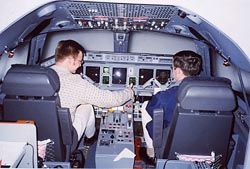
More training for pilots on advanced simulators could help prevent crashes and save hundreds of lives, according to an analysis by USA Today. Many pilots today are trained on older simulators that can’t effectively re-create the real behavior of aircraft during stalls, severe icing, upsets due to wind shear or wake encounters, and other extreme conditions, says a recent NTSB report. Loss of control was a factor in 73 percent of the 433 airline fatalities in the U.S. since 2000. (Note that the fatalities that occurred on Sept. 11, 2001, are not counted in accident statistics, since they resulted from a crime, not an accident.) Newer simulators created with research by the military and NASA are more effective, but there are no federal requirements for pilots to be trained on them.
At a conference in London last June, representatives from Boeing reported that they had conducted tests with new simulators using data from recent NASA research to improve aerodynamic fidelity, and the results were positive. They tested several pilots after upset training with their enhanced simulator. “The conclusion was that upset recovery training typically enables the pilot to complete the maneuver without exceeding the validated flight envelope,” according to the NTSB report, issued in December. A representative from Boeingsummarized the consensus of the conference, according to the report, when he said, “There are certainly ways to effect realistic representative stall characteristics … The reason those aren’t there today is because there has not been a requirement.” The report cites several loss-of-control accidents in which the crew’s lack of practice in handling upsets contributed to the crash.


































